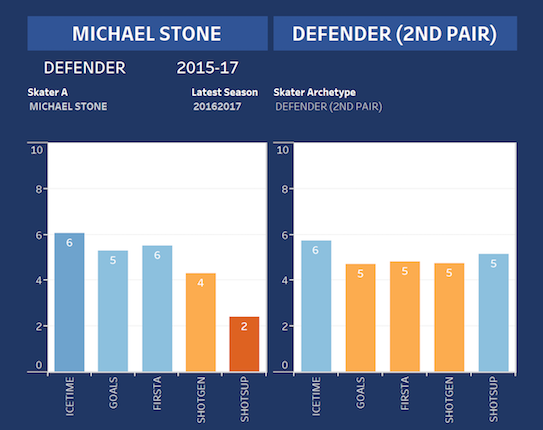UFA Profile: Michael Stone

The acquisition of Michael Stone in late February put the rest of the league on notice the Calgary Flames were out to make some postseason noise. The Flames sent a 2017 third round pick and a 2018 fifth round pick to Arizona for Stone and the move seemed to pay immediate dividends. The trade carried with it a little uncertainty, though, as Stone is now a pending unrestricted free agent. So did Stone truly solidify Calgary’s backend upon arrival? Or is it buyer beware on a potential return?
As our free agent profiles continue, here’s what we’ve put together so far:
- Sam Bennett (RFA)
- Curtis Lazar (RFA)
- Alex Chiasson (RFA)
- Micheal Ferland (RFA)
- Deryk Engelland (UFA)
Now let’s take a closer look at Stone.
Evidence
Stone’s acquisition looked to be an instant hit, mainly because Calgary rattled off 10 straight wins starting with his debut with the team in Nashville. Stone wasn’t the central reason for that torrid run, but things did seem to settle down on the blueline from that point forward. Stone paired with T.J. Brodie and Matt Bartkowski, who debuted the game prior, formed a pair with Deryk Engelland.
More than anything else, the additions of Stone and Bartkowski pushed Dennis Wideman out of the lineup for the majority of the team’s remaining games. While his underlying numbers weren’t horrible, Wideman was seemingly good for at least one catastrophic mistake per game at the time and was in way over his head alongside Brodie. All things considered, Brodie looked far more comfortable with Stone than with any other partner.
As for Stone, his situation improved dramatically after the trade. He went from a bottom feeding team to a bona fide playoff group in the snap of a finger, while also returning to the city he starred in for four junior seasons. In terms of results, Stone’s counting numbers improved while his underlying outputs stayed about the same.

So, Stone was used in a similar role with the Flames as with the Coyotes and his possession metrics really only improved relative to his offensive starts. Yes, his production spiked significantly with Calgary, but so did his on-ice luck, as his PDO ramped up by almost three full points. Accounting for those percentages, Stone was essentially the same player with the Flames as he was in Arizona.
Deliberation
Prior to the 2016-17 season, the Coyotes signed Stone to a one-year, $4 million contract. He was coming off a career season in Arizona and was set to go to arbitration, so he had a decent amount of leverage. Stone was being paid like a second pairing defenceman last season, but most evidence would suggest that’s not the ideal spot for him. That evidence includes a handy HERO Chart from Own The Puck.

As the chart illustrates, over the last three seasons Stone has put up points comparable and/or better than a 3-4 blueliner. Where he has fallen short, though, is on the possession side, as he’s been below average in both generating and suppressing shots. What you see above would suggest Stone is a better fit on a third pairing as opposed to the top four.
That seems to correlate with what I saw in Stone’s short time with the Flames last season. While he has a cannon of a shot and uses his 6’3, 210 pound frame well, he struggles in some key defensive areas. Stone isn’t the fleetest of foot, which hampers him in suppressing zone entries specifically.
Once in a defensive posture, Stone’s biggest strength is using his frame to break up cycles along the end boards and corners. Head coach Glen Gulutzan made numerous references to Stone’s work in “sealing out” during the latter parts of the season, and it’s easily noticeable when watching him play. Because Stone struggles suppressing entries, though, he spends more time on the back foot than desirable.
What’s also really interesting is looking at Stone’s impact on Brodie. The popular narrative was that the latter played his best hockey partnered with Stone, and I’m not saying that’s false. In fact, by my eye, that seemed to jive, as Brodie looked more comfortable after February’s trade. When comparing Brodie’s minutes with and without Stone, it paints an interesting picture.

At first glance, you might take a look and say “actually, Brodie was worse with Stone”. I don’t think that’s the case, though. Gulutzan was far more comfortable deploying Brodie defensively with Stone than with Wideman, as evidenced by the above zone start ratios. In fact, Brodie outperformed his deployment paired with Stone better than he did with Wideman, and by a decent margin. As such, I think it’s safe to say Brodie was a tad better with Stone than without.
Verdict
This is an interesting discussion, because I don’t think Calgary would be wrong to sign Stone to another contract. I would disagree, however, if the Flames decided to bring him back to fill a top four role at or above his 2016-17 salary. If they’re going to do it, I think it has to be at a heavily reduced price relative to a reduced role on the team. As such, a one- or two-year deal at $2 million would be reasonable, I think.
With or without Stone, though, I believe Calgary needs to add a true number four defenceman for next season. By doing that, re-signing Stone seems to make sense. Without that upgrade, though, pushing Stone into a top four role is a risky proposition.
Recent articles from Pat Steinberg





